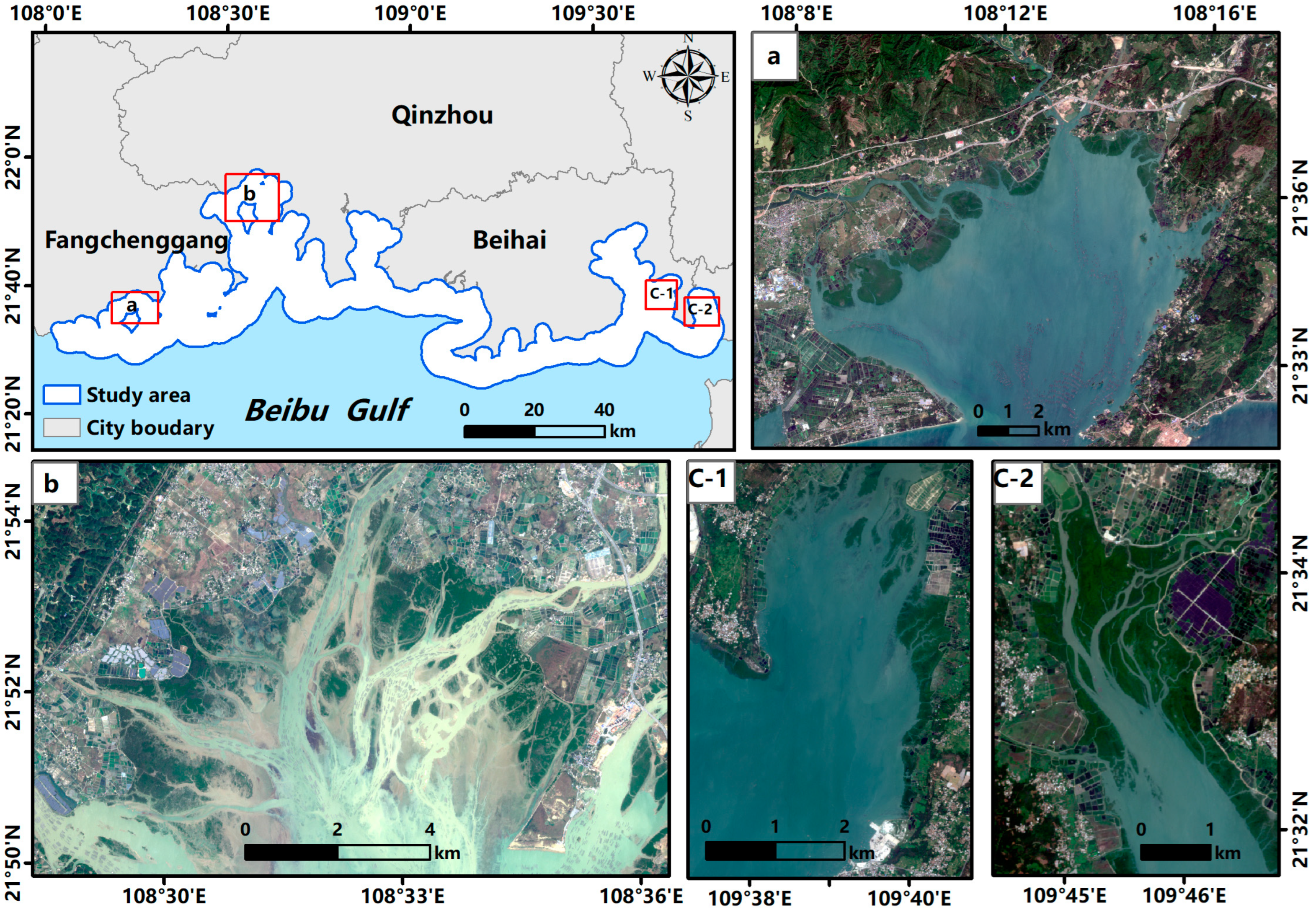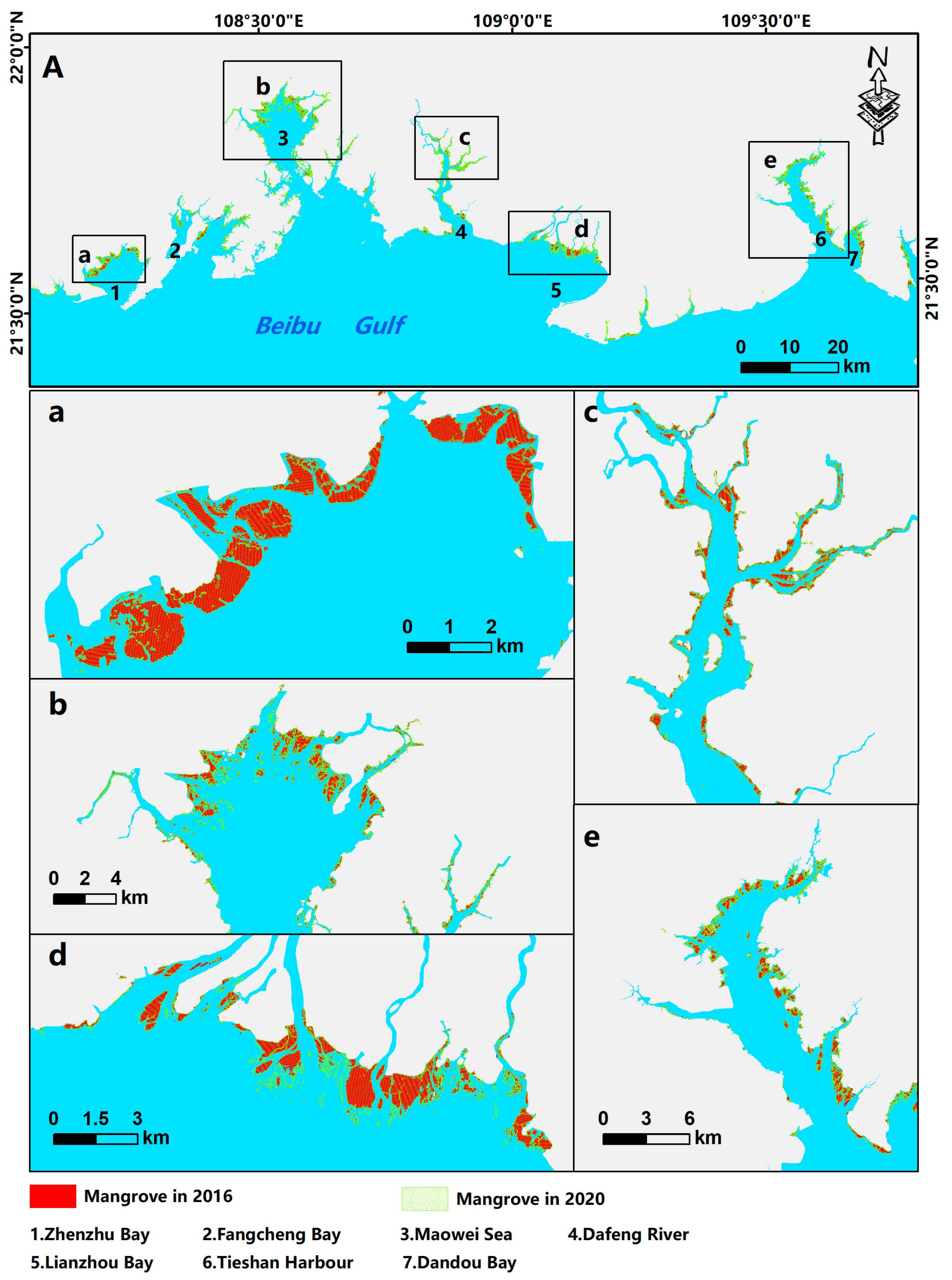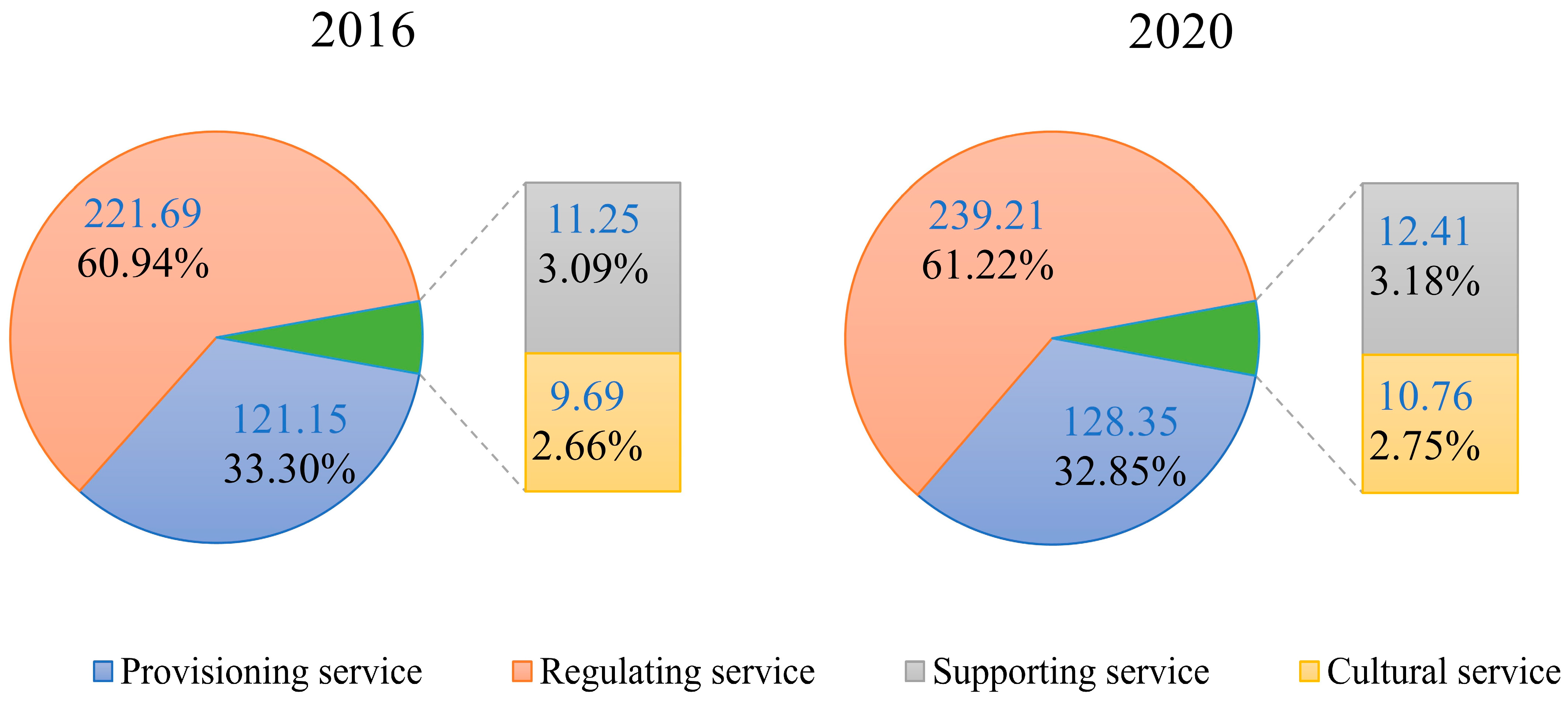Evaluating Ecosystem Service Value Changes in Mangrove Forests in Guangxi, China, from 2016 to 2020
Abstract
1. Introduction
2. Materials and Methods
2.1. Study Area
2.2. Sentinel-2 Data Acquisition and Pre-Processing
2.3. Field Investigation and Other Data
2.4. Classification Methods and Accuracy Assessment
2.5. Spatial Pattern of Mangrove Forests
2.6. Assessment of Ecosystem Service Value
3. Results
3.1. Accuracy Assessment of Mangrove Forests Map
3.2. Spatial Distribution and Pattern of Guangxi’s Mangrove Forests
3.3. Variations in ESV
4. Discussion
4.1. Factors Driving Changes in Spatial Pattern
4.2. The Rationality and Existing Problems of Selecting Evaluation Index
4.3. Threatened Situations
5. Conclusions
Author Contributions
Funding
Data Availability Statement
Acknowledgments
Conflicts of Interest
References
- Myint, S.W.; Giri, C.P.; Wang, L.; Zhu, Z.; Gillette, S.C. Identifying Mangrove Species and Their Surrounding Land Use and Land Cover Classes Using an Object-Oriented Approach with a Lacunarity Spatial Measure. GIScience Remote Sens. 2008, 45, 188–208. [Google Scholar] [CrossRef]
- Mukherjee, N.; Sutherland, W.J.; Dicks, L.; Hugé, J.; Koedam, N.; Dahdouh-Guebas, F. Ecosystem Service Valuations of Mangrove Ecosystems to Inform Decision Making and Future Valuation Exercises. PLoS ONE 2014, 9, e107706. [Google Scholar] [CrossRef] [PubMed]
- Zeng, H.; Jia, M.; Zhang, R.; Wang, Z.; Mao, D.; Ren, C.; Zhao, C. Monitoring the Light Pollution Changes of China’s Mangrove Forests from 1992–2020 Using Nighttime Light Data. Front. Mar. Sci. 2023, 10, 1187702. [Google Scholar] [CrossRef]
- Cherrington, E.A.; Griffin, R.E.; Anderson, E.R.; Hernandez Sandoval, B.E.; Flores-Anderson, A.I.; Muench, R.E.; Markert, K.N.; Adams, E.C.; Limaye, A.S.; Irwin, D.E. Use of Public Earth Observation Data for Tracking Progress in Sustainable Management of Coastal Forest Ecosystems in Belize, Central America. Remote Sens. Environ. 2020, 245, 111798. [Google Scholar] [CrossRef]
- Lovelock, C.E.; Barbier, E.; Duarte, C.M. Tackling the Mangrove Restoration Challenge. PLoS Biol. 2022, 20, e3001836. [Google Scholar] [CrossRef] [PubMed]
- Pendleton, L.; Mongruel, R.; Beaumont, N.; Hooper, T.; Charles, M. A Triage Approach to Improve the Relevance of Marine Ecosystem Services Assessments. Mar. Ecol. Prog. Ser. 2015, 530, 183–193. [Google Scholar] [CrossRef]
- Sannigrahi, S.; Chakraborti, S.; Joshi, P.K.; Keesstra, S.; Sen, S.; Paul, S.K.; Kreuter, U.; Sutton, P.C.; Jha, S.; Dang, K.B. Ecosystem Service Value Assessment of a Natural Reserve Region for Strengthening Protection and Conservation. J. Environ. Manag. 2019, 244, 208–227. [Google Scholar] [CrossRef] [PubMed]
- Himes-Cornell, A.; Grose, S.O.; Pendleton, L. Mangrove Ecosystem Service Values and Methodological Approaches to Valuation: Where Do We Stand? Front. Mar. Sci. 2018, 5, 376. [Google Scholar] [CrossRef]
- Cao, L.; Li, J.; Ye, M.; Pu, R.; Liu, Y.; Guo, Q.; Feng, B.; Song, X. Changes of Ecosystem Service Value in a Coastal Zone of Zhejiang Province, China, during Rapid Urbanization. Int. J. Environ. Res. Public Health 2018, 15, 1301. [Google Scholar] [CrossRef]
- Ligate, E.J.; Chen, C.; Wu, C. Evaluation of Tropical Coastal Land Cover and Land Use Changes and Their Impacts on Ecosystem Service Values. Ecosyst. Health Sustain. 2018, 4, 188–204. [Google Scholar] [CrossRef]
- Yang, Q.; Liu, G.; Hao, Y.; Zhang, L.; Giannetti, B.F.; Wang, J.; Casazza, M. Donor-Side Evaluation of Coastal and Marine Ecosystem Services. Water Res. 2019, 166, 115028. [Google Scholar] [CrossRef]
- De Groot, R.; Brander, L.; Van Der Ploeg, S.; Costanza, R.; Bernard, F.; Braat, L.; Christie, M.; Crossman, N.; Ghermandi, A.; Hein, L.; et al. Global Estimates of the Value of Ecosystems and Their Services in Monetary Units. Ecosyst. Serv. 2012, 1, 50–61. [Google Scholar] [CrossRef]
- Brander, L.M.; Wagtendonk, A.J.; Hussain, S.S.; McVittie, A.; Verburg, P.H.; De Groot, R.S.; Van Der Ploeg, S. Ecosystem Service Values for Mangroves in Southeast Asia: A Meta-Analysis and Value Transfer Application. Ecosyst. Serv. 2012, 1, 62–69. [Google Scholar] [CrossRef]
- Gaodi, X.; Lin, Z.; Chunxia, L.; Yu, X.; Wenhua, L. Applying Value Transfer Method for Eco-Service Valuation in China. J. Resour. Ecol. 2010, 1, 51–59. [Google Scholar] [CrossRef]
- Camacho-Valdez, V.; Ruiz-Luna, A.; Ghermandi, A.; Berlanga-Robles, C.A.; Nunes, P.A.L.D. Effects of Land Use Changes on the Ecosystem Service Values of Coastal Wetlands. Environ. Manag. 2014, 54, 852–864. [Google Scholar] [CrossRef] [PubMed]
- Yushanjiang, A.; Zhang, F.; Kung, H.; Li, Z. Spatial–Temporal Variation of Ecosystem Service Values in Ebinur Lake Wetland National Natural Reserve from 1972 to 2016, Xinjiang, Arid Region of China. Environ. Earth Sci. 2018, 77, 586. [Google Scholar] [CrossRef]
- Zhang, H.; Chen, C.; Zhang, H.; Zhang, L.; Jia, G. Evaluation of Value of Wetland Ecosystem Services of Zhangjiang Estuary Mangrove National Nature Reserve. Wetl. Sci. 2013, 11, 108–113. [Google Scholar] [CrossRef]
- Harborne, A.R.; Mumby, P.J.; Micheli, F.; Perry, C.T.; Dahlgren, C.P.; Holmes, K.E.; Brumbaugh, D.R. The Functional Value of Caribbean Coral Reef, Seagrass and Mangrove Habitats to Ecosystem Processes. In Advances in Marine Biology; Elsevier: Amsterdam, The Netherlands, 2006; Volume 50, pp. 57–189. ISBN 978-0-12-026151-2. [Google Scholar]
- Li, Y.; Wen, H.; Wang, F. Analysis of the Evolution of Mangrove Landscape Patterns and Their Drivers in Hainan Island from 2000 to 2020. Sustainability 2022, 15, 759. [Google Scholar] [CrossRef]
- Pham, T.; Yokoya, N.; Bui, D.; Yoshino, K.; Friess, D. Remote Sensing Approaches for Monitoring Mangrove Species, Structure, and Biomass: Opportunities and Challenges. Remote Sens. 2019, 11, 230. [Google Scholar] [CrossRef]
- Tian, J.; Wang, L.; Li, X.; Gong, H.; Shi, C.; Zhong, R.; Liu, X. Comparison of UAV and WorldView-2 Imagery for Mapping Leaf Area Index of Mangrove Forest. Int. J. Appl. Earth Obs. Geoinf. 2017, 61, 22–31. [Google Scholar] [CrossRef]
- Jia, M.; Wang, Z.; Zhang, Y.; Mao, D.; Wang, C. Monitoring Loss and Recovery of Mangrove Forests during 42 Years: The Achievements of Mangrove Conservation in China. Int. J. Appl. Earth Obs. Geoinf. 2018, 73, 535–545. [Google Scholar] [CrossRef]
- Matejicek, L.; Kopackova, V. Changes in Croplands as a Result of Large Scale Mining and the Associated Impact on Food Security Studied Using Time-Series Landsat Images. Remote Sens. 2010, 2, 1463–1480. [Google Scholar] [CrossRef]
- Zhang, R.; Jia, M.; Wang, Z.; Zhou, Y.; Wen, X.; Tan, Y.; Cheng, L. A Comparison of Gaofen-2 and Sentinel-2 Imagery for Mapping Mangrove Forests Using Object-Oriented Analysis and Random Forest. IEEE J. Sel. Top. Appl. Earth Obs. Remote Sens. 2021, 14, 4185–4193. [Google Scholar] [CrossRef]
- Zhao, C.; Jia, M.; Wang, Z.; Mao, D.; Wang, Y. Toward a Better Understanding of Coastal Salt Marsh Mapping: A Case from China Using Dual-Temporal Images. Remote Sens. Environ. 2023, 295, 113664. [Google Scholar] [CrossRef]
- Ghorbanian, A.; Zaghian, S.; Asiyabi, R.M.; Amani, M.; Mohammadzadeh, A.; Jamali, S. Mangrove Ecosystem Mapping Using Sentinel-1 and Sentinel-2 Satellite Images and Random Forest Algorithm in Google Earth Engine. Remote Sens. 2021, 13, 2565. [Google Scholar] [CrossRef]
- Zhang, L.; Xu, S. Discussion about the Eco-function of Mangrove Wetlands of Beibu gulf of Guangxi Zhuang Nationality Autonomous Region. Anhui Agri. Sci. Bull. 2010, 16, 134–136. [Google Scholar] [CrossRef]
- Li, C. Quantitative distribution of mangroves in Guangxi Zhuang Autonmous Region. J. Beijing For. Univ. 2004, 26, 47–52. [Google Scholar] [CrossRef]
- Jia, M.; Wang, Z.; Mao, D.; Ren, C.; Wang, C.; Wang, Y. Rapid, Robust, and Automated Mapping of Tidal Flats in China Using Time Series Sentinel-2 Images and Google Earth Engine. Remote Sens. Environ. 2021, 255, 112285. [Google Scholar] [CrossRef]
- Jia, M.; Wang, Z.; Mao, D.; Ren, C.; Song, K.; Zhao, C.; Wang, C.; Xiao, X.; Wang, Y. Mapping Global Distribution of Mangrove Forests at 10-m Resolution. Sci. Bull. 2023, 68, 1306–1316. [Google Scholar] [CrossRef]
- Powers, R.P.; Hay, G.J.; Chen, G. How Wetland Type and Area Differ through Scale: A GEOBIA Case Study in Alberta’s Boreal Plains. Remote Sens. Environ. 2012, 117, 135–145. [Google Scholar] [CrossRef]
- Guo, X.; Zhang, C.; Luo, W.; Yang, J.; Yang, M. Urban Impervious Surface Extraction Based on Multi-Features and Random Forest. IEEE Access 2020, 8, 226609–226623. [Google Scholar] [CrossRef]
- Liu, M.; Mao, D.; Wang, Z.; Li, L.; Man, W.; Jia, M.; Ren, C.; Zhang, Y. Rapid Invasion of Spartina Alterniflora in the Coastal Zone of Mainland China: New Observations from Landsat OLI Images. Remote Sens. 2018, 10, 1933. [Google Scholar] [CrossRef]
- Belgiu, M.; Drăguţ, L. Random Forest in Remote Sensing: A Review of Applications and Future Directions. ISPRS J. Photogramm. Remote Sens. 2016, 114, 24–31. [Google Scholar] [CrossRef]
- Vuolo, F.; Neuwirth, M.; Immitzer, M.; Atzberger, C.; Ng, W.-T. How Much Does Multi-Temporal Sentinel-2 Data Improve Crop Type Classification? Int. J. Appl. Earth Obs. Geoinf. 2018, 72, 122–130. [Google Scholar] [CrossRef]
- Li, C.; Xia, Y.; Dai, H. Temporal Analysis on Spatial Structure of Mangrove Distribution in Guangxi, China from 1960 to 2010. Wetl. Sci. 2015, 13, 265–275. [Google Scholar] [CrossRef]
- Kang, N.; Hou, L.; Huang, J.; Liu, H. Ecosystem Services Valuation in China: A Meta-Analysis. Sci. Total Environ. 2022, 809, 151122. [Google Scholar] [CrossRef] [PubMed]
- Zhang, Q. Research on the Biologic Seashore of South China Sea; Guangdong Economic Press: Guangzhou, China, 2008. [Google Scholar]
- Yanagisawa, H.; Koshimura, S.; Goto, K.; Miyagi, T.; Imamura, F.; Ruangrassamee, A.; Tanavud, C. The Reduction Effects of Mangrove Forest on a Tsunami Based on Field Surveys at Pakarang Cape, Thailand and Numerical Analysis. Estuar. Coast. Shelf Sci. 2009, 81, 27–37. [Google Scholar] [CrossRef]
- Han, W.; Gao, X.; Lu, C.; Lin, P. The Ecological Values of Mangrove Ecosystems in China. Ecol. Sci. 2000, 19, 40–45. [Google Scholar]
- China Forestry and Grassland Statistical Yearbook; China Forestry Publishing House: Beijing, China, 2020.
- Fan, H.; Zhang, Y.; Zou, L.; Pan, L. A study on the baseline value of the Chinese mangrove services and allocation of the value to individual tree. Acta Ecol. Sin. 2022, 42, 1262–1275. [Google Scholar] [CrossRef]
- Chen, S.; Wen, Z. Estimating Forest Ecosystem Service Function of Carbon Sequestration and Oxygen Release in Guangxi Province. J. Agro-For. Econ. Manag. 2016, 15, 557–563. [Google Scholar] [CrossRef]
- Lu, X. Wetland Protection and Management; Chemical Industry Press: Beijing, China, 2004. [Google Scholar]
- Guangxi Statistical Yearbook; China Statistics Press: Beijing, China, 2020.
- Xie, G.; Zhang, C.; Lei, M.; Chen, W.; Li, S. Improvement of the Evaluation Method for Ecosystem Service Value Based on Per Unit Area. J. Nat. Resour. 2015, 30, 1243–1252. [Google Scholar] [CrossRef]
- Chen, Z.; Zhang, X. Value of Ecosystem Services in China. Chin. Sci. Bull. 2000, 45, 870–876. [Google Scholar] [CrossRef]
- Hu, L.; Li, W.; Xu, B. Monitoring Mangrove Forest Change in China from 1990 to 2015 Using Landsat-Derived Spectral-Temporal Variability Metrics. Int. J. Appl. Earth Obs. Geoinf. 2018, 73, 88–98. [Google Scholar] [CrossRef]
- Ellison, A.M.; Felson, A.J.; Friess, D.A. Mangrove Rehabilitation and Restoration as Experimental Adaptive Management. Front. Mar. Sci. 2020, 7, 327. [Google Scholar] [CrossRef]
- Costanza, R.; d’Arge, R.; de Groot, R.; Stephen, F.; Monica, G. The Value of the World Ecosystem Services and Natural Capital. Nature 1997, 387, 253–260. [Google Scholar] [CrossRef]
- Lautenbach, S.; Kugel, C.; Lausch, A.; Seppelt, R. Analysis of Historic Changes in Regional Ecosystem Service Provisioning Using Land Use Data. Ecol. Indic. 2011, 11, 676–687. [Google Scholar] [CrossRef]
- Kelleway, J.J.; Cavanaugh, K.; Rogers, K.; Feller, I.C.; Ens, E.; Doughty, C.; Saintilan, N. Review of the Ecosystem Service Implications of Mangrove Encroachment into Salt Marshes. Glob. Chang. Biol. 2017, 23, 3967–3983. [Google Scholar] [CrossRef] [PubMed]
- Anneboina, L.R.; Kavi Kumar, K.S. Economic Analysis of Mangrove and Marine Fishery Linkages in India. Ecosyst. Serv. 2017, 24, 114–123. [Google Scholar] [CrossRef]
- Wang, X.; Xiao, X.; Xu, X.; Zou, Z.; Chen, B.; Qin, Y.; Zhang, X.; Dong, J.; Liu, D.; Pan, L.; et al. Rebound in China’s Coastal Wetlands Following Conservation and Restoration. Nat. Sustain. 2021, 4, 1076–1083. [Google Scholar] [CrossRef]
- Jia, M.; Wang, Z.; Mao, D.; Huang, C.; Lu, C. Spatial-temporal changes of China’s mangrove forests over the past 50 years: An analysis towards the Sustainable Development Goals (SDGs). Chin. Sci. Bull. 2021, 66, 3886–3901. [Google Scholar] [CrossRef]



| Feature Type | Classification Feature |
|---|---|
| Spectral feature | Mean value of band 2 3 4 8, Standard deviation of band 2 3 4 8 |
| Spatial feature | Shape index, Compactness index, Border index, Homogeneity, Contrast |
| Vegetation index | Normalized Difference Vegetation Index, Normalized Difference Water Index |
| Indices | Description |
|---|---|
| Abundance of mangrove | The area of mangroves per unit length of coastline (ha/km). |
| Number of patches | The number of mangrove patches. |
| Average patch area | The average area of all mangrove patches (ha). |
| Mangrove shoreline | Shoreline with mangroves (km) |
| Coastwards mangrove | Mangroves with a minimum distance between the landward boundary and the coastline less than 30 m. |
| Ideally distributed mangrove | Shoreline mangrove with a patch width ≥ 100 m and coverage ≥ 0.4 |
| Category | Type | Evaluation Index | Equation |
|---|---|---|---|
| Provisioning service | Material production value | Wood production | |
| Fishery | |||
| Regulating service | Soil conservation value | Soil conservation | |
| Fertilizer conservation | |||
| wave absorbing revetment | Mangrove shoreline | ||
| Climate regulation | CO2 | ||
| O2 | |||
| CH4 | |||
| Pollution purification | Degrade pollutants | ||
| Water conservation | Water | ||
| Supporting service | Biodiversity Conservation | Habitat | |
| Nutrient accumulation | Nutrient | ||
| Cultural service | Cultural | Scientific Research and education | |
| Recreation | Recreation |
| Year | Actual Type | Mangrove | Non- Mangrove | Total | User’s Accuracy | Producer’s Accuracy | Overall Accuracy | Kappa Coefficient |
|---|---|---|---|---|---|---|---|---|
| 2016 | mangrove | 210 | 14 | 224 | 93.75% | 89.36% | 93.05% | 0.86 |
| non-mangrove | 25 | 312 | 337 | 92.58% | 95.71% | |||
| 2020 | mangrove | 215 | 9 | 224 | 95.98% | 92.67% | 95.37% | 0.90 |
| non-mangrove | 17 | 320 | 337 | 94.96% | 97.26% |
| Spatial Indices | Year of 2016 | Year of 2020 | Proportion of Changes |
|---|---|---|---|
| Abundance of mangrove (ha/km) | 3.70 | 3.91 | 5.71% |
| Number of patches (pcs) | 1018 | 1060 | 4.13% |
| Average patch area (ha) | 6.14 | 6.37 | 3.80% |
| Mangrove shoreline (km) | 578.90 | 597.37 | 3.19% |
| Coastwards mangrove (ha) | 5436.97 | 5692.19 | 4.69% |
| Ideally distributed mangrove (ha) | 5114.972 | 5201.398 | 4.20% |
| Service | 2016 | 2020 | ||
|---|---|---|---|---|
| Value | Proportion | Value | Proportion | |
| Wood | 3.25 | 0.89% | 2.89 | 0.74% |
| Fishery | 117.89 | 32.41% | 125.47 | 32.11% |
| Soil consolidation | 0.11 | 0.03% | 0.12 | 0.03% |
| Fertilizer conservation | 76.71 | 21.09% | 81.63 | 20.89% |
| Wave absorbing revetment | 54.20 | 14.90% | 55.60 | 14.23% |
| Carbon fixation | 24.45 | 6.72% | 25.75 | 6.59% |
| Oxygen release | 11.33 | 3.11% | 17.38 | 4.45% |
| Methane release | −1.24 | −0.34% | −1.32 | −0.34% |
| Pollution purification | 36.33 | 9.99% | 38.66 | 9.89% |
| Water conservation | 19.80 | 5.44% | 21.40 | 5.48% |
| Habitat | 10.58 | 2.91% | 11.70 | 2.99% |
| Nutrient accumulation | 0.67 | 0.18% | 0.72 | 0.18% |
| Scientific research | 2.97 | 0.82% | 3.21 | 0.82% |
| Recreation | 6.72 | 1.85% | 7.55 | 1.93% |
| Total | 363.78 | 390.74 | ||
Disclaimer/Publisher’s Note: The statements, opinions and data contained in all publications are solely those of the individual author(s) and contributor(s) and not of MDPI and/or the editor(s). MDPI and/or the editor(s) disclaim responsibility for any injury to people or property resulting from any ideas, methods, instructions or products referred to in the content. |
© 2024 by the authors. Licensee MDPI, Basel, Switzerland. This article is an open access article distributed under the terms and conditions of the Creative Commons Attribution (CC BY) license (https://creativecommons.org/licenses/by/4.0/).
Share and Cite
Wang, K.; Jia, M.; Zhang, X.; Zhao, C.; Zhang, R.; Wang, Z. Evaluating Ecosystem Service Value Changes in Mangrove Forests in Guangxi, China, from 2016 to 2020. Remote Sens. 2024, 16, 494. https://doi.org/10.3390/rs16030494
Wang K, Jia M, Zhang X, Zhao C, Zhang R, Wang Z. Evaluating Ecosystem Service Value Changes in Mangrove Forests in Guangxi, China, from 2016 to 2020. Remote Sensing. 2024; 16(3):494. https://doi.org/10.3390/rs16030494
Chicago/Turabian StyleWang, Kedong, Mingming Jia, Xiaohai Zhang, Chuanpeng Zhao, Rong Zhang, and Zongming Wang. 2024. "Evaluating Ecosystem Service Value Changes in Mangrove Forests in Guangxi, China, from 2016 to 2020" Remote Sensing 16, no. 3: 494. https://doi.org/10.3390/rs16030494
APA StyleWang, K., Jia, M., Zhang, X., Zhao, C., Zhang, R., & Wang, Z. (2024). Evaluating Ecosystem Service Value Changes in Mangrove Forests in Guangxi, China, from 2016 to 2020. Remote Sensing, 16(3), 494. https://doi.org/10.3390/rs16030494









